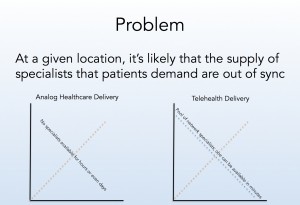The Atlantic just wrote a piece highlighting the growing trend of non-physicians (commonly referred to as midlevels) providing healthcare. The reason is simple: supply and demand–more precisely, a fixed supply.
For any location where a patient demands healthcare services, there is only a binary result: either there is a qualified healthcare professional available to deliver care, or not. This slide (from Pristine’s investor presentation) illustrates this:
The supply and demand problem is further compounded by an archaic regulatory system. The path toward becoming a physician, at least in the US, is so arduous that the decision to pursue becoming an MD must be made by age 18 or 19. Even if a huge cohort of 18 year olds suddenly decided they wanted to be physicians, the artificially capped supply of available residency slots each year stimies traditional supply and demand economics.
Nursing, on the other hand, has a more varied cohort in terms of age of entry. Many nurses don’t enter the profession until well into their late 20s or 30s. The same is true of physician assistants. This has resulted in a more liquid supply of non-physician practitioners, and these non-physician practitioners are available to respond to the influx of new patients resulting from the ACA, and to the growing number of retiring baby boomer population.
Given the fixed supply of physicians, there are two fundamental ways to solve the supply and demand problem: make physicians more efficient, or substitute physicians with others who can do an equally good job for a given patient’s needs.
The realities of practitioner supply suggest that nurses and other non-physician practitioners will deliver an increasingly large percentage of healthcare services. Physicians will be relegated to the “high end” per Clayton Christensen’s disruption theory. That could manifest itself in a future in which midlevels deliver primary care and triage more acute conditions to “higher end” specialist physicians.
The greatest challenge in the triage-centric model led by midlevels is the (historically quite poor) communication among healthcare providers. We will need a robust technological infrastructure to support the seamless transfer of patient data among providers. Additionally, we’ll need more capable communication tools to empower providers to connect with one another and with patients regardless of location.
Telemedicine seems to be taking hold to power a future in which location is irrelevant. Interoperability is improving within health enterprises, though there are some signs that community health information exchanges (HIEs) are not doing as well as many had hoped.
At some point down the line, we’ll likely look back and wonder why location mattered so much. It shouldn’t, and because of telemedicine, and liquid data connectivity, it won’t.















[…] Percentage of complex visits handled by an MD (in which the intention is to hand off simpler visits/procedures to non-physician practitioners to lower […]
[…] doctors that could happen. In fact, Kyle Samani covered some of this shortage in his post, “The Nurse Will See You Now.” In that post he talks about the limited number of residency slots that are available. Not […]